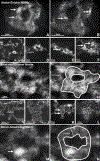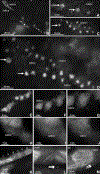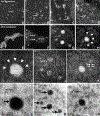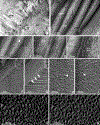Particle-Attachment-Mediated and Matrix/Lattice-Guided Enamel Apatite Crystal Growth
- PMID: 30763075
- PMCID: PMC7067265
- DOI: 10.1021/acsnano.8b08668
Particle-Attachment-Mediated and Matrix/Lattice-Guided Enamel Apatite Crystal Growth
Abstract
Tooth enamel is a hard yet resilient biomaterial that derives its unique mechanical properties from decussating bundles of apatite crystals. To understand enamel crystal nucleation and growth at a nanoscale level and to minimize preparation artifacts, the developing mouse enamel matrix was imaged in situ using graphene liquid cells and atomic resolution scanning transmission electron and cryo-fracture electron microscopy. We report that 1-2 nm diameter mineral precipitates aggregated to form larger 5 nm particle assemblies within ameloblast secretory vesicles or annular organic matrix subunits. Further evidence for the fusion of 1-2 nm mineral precipitates into 5 nm mineral aggregates via particle attachment was provided by matrix-mediated calcium phosphate crystal growth studies. As a next step, aggregated particles organized into rows of 3-10 subunits and developed lattice suprastructures with 0.34 nm gridline spacings corresponding to the (002) planes of apatite crystals. Mineral lattice suprastructures superseded closely matched organic matrix patterns, suggestive of a combination of organic/inorganic templates guiding apatite crystal growth. Upon assembly of 2-5 nm subunits into crystal ribbons, lattice fringes indicative of the presence of larger ordered crystallites were observed surrounding elongating crystal ribbons, presumably guiding the c-axis growth of composite apatite crystals. Cryo-fracture micrographs revealed reticular networks of an organic matrix on the surface of elongating enamel crystal ribbons, suggesting that protein coats facilitate c-axis apatite crystal growth. Together, these data demonstrate (i) the involvement of particle attachment in enamel crystal nucleation, (ii) a combination of matrix- and lattice-guided crystal growth, and (iii) fusion of individual crystals via a mechanism similar to Ostwald ripening.
Keywords: apatite; atomic scale microscopy; crystal growth; enamel; graphene liquid cell.
Figures






Similar articles
-
Amelogenesis: Transformation of a protein-mineral matrix into tooth enamel.J Struct Biol. 2021 Dec;213(4):107809. doi: 10.1016/j.jsb.2021.107809. Epub 2021 Nov 6. J Struct Biol. 2021. PMID: 34748943 Free PMC article. Review.
-
Modulation of apatite crystal growth on Bioglass by recombinant amelogenin.Biomaterials. 1999 Sep;20(18):1717-25. doi: 10.1016/s0142-9612(99)00085-x. Biomaterials. 1999. PMID: 10503973
-
Posttranslational Amelogenin Processing and Changes in Matrix Assembly during Enamel Development.Front Physiol. 2017 Oct 17;8:790. doi: 10.3389/fphys.2017.00790. eCollection 2017. Front Physiol. 2017. PMID: 29089900 Free PMC article.
-
Control of apatite crystal growth in a fluoride containing amelogenin-rich matrix.Biomaterials. 2005 May;26(13):1595-603. doi: 10.1016/j.biomaterials.2004.05.009. Biomaterials. 2005. PMID: 15522761
-
Structure, crystal chemistry and density of enamel apatites.Ciba Found Symp. 1997;205:54-67; discussion 67-72. Ciba Found Symp. 1997. PMID: 9189617 Review.
Cited by
-
The Development of iDPC-STEM and Its Application in Electron Beam Sensitive Materials.Molecules. 2022 Jun 14;27(12):3829. doi: 10.3390/molecules27123829. Molecules. 2022. PMID: 35744947 Free PMC article. Review.
-
Advanced materials for enamel remineralization.Front Bioeng Biotechnol. 2022 Sep 13;10:985881. doi: 10.3389/fbioe.2022.985881. eCollection 2022. Front Bioeng Biotechnol. 2022. PMID: 36177189 Free PMC article. Review.
-
Influence of Acidic Environment on Hydrolytic Stability of MDP-Ca Salts with Nanolayered and Amorphous Structures.Int J Nanomedicine. 2022 Apr 13;17:1695-1709. doi: 10.2147/IJN.S357823. eCollection 2022. Int J Nanomedicine. 2022. PMID: 35444417 Free PMC article.
-
3D-Printed Strong Dental Crown with Multi-Scale Ordered Architecture, High-Precision, and Bioactivity.Adv Sci (Weinh). 2022 Feb;9(5):e2104001. doi: 10.1002/advs.202104001. Epub 2021 Dec 22. Adv Sci (Weinh). 2022. PMID: 34936228 Free PMC article.
-
Biomimetic mineralisation systems for in situ enamel restoration inspired by amelogenesis.J Mater Sci Mater Med. 2021 Aug 28;32(9):115. doi: 10.1007/s10856-021-06583-x. J Mater Sci Mater Med. 2021. PMID: 34455518 Free PMC article. Review.
References
-
- Lowenstam HA Minerals Formed by Organisms. Science 1981, 211, 1126–1131. - PubMed
-
- Mann S Biomineralization: Principles and Concepts in Bioinorganic Materials Chemistry Oxford University Press: Oxford, UK, 2001; pp 3.
-
- Diekwisch T; David S; Bringas P Jr; Santos V; Slavkin HC Antisense Inhibition of AMEL Translation Demonstrates Supramolecular Controls for Enamel HAP Crystal Growth during Embryonic Mouse Molar Development. Development 1993, 117, 471–482. - PubMed
-
- Diekwisch TG; Berman BJ; Gentner S; Slavkin HC Initial Enamel Crystals are not Spatially Associated with Mineralized Dentine. Cell Tissue Res 1995, 279, 49–67. - PubMed
Publication types
MeSH terms
Substances
Grants and funding
LinkOut - more resources
Full Text Sources
Research Materials

